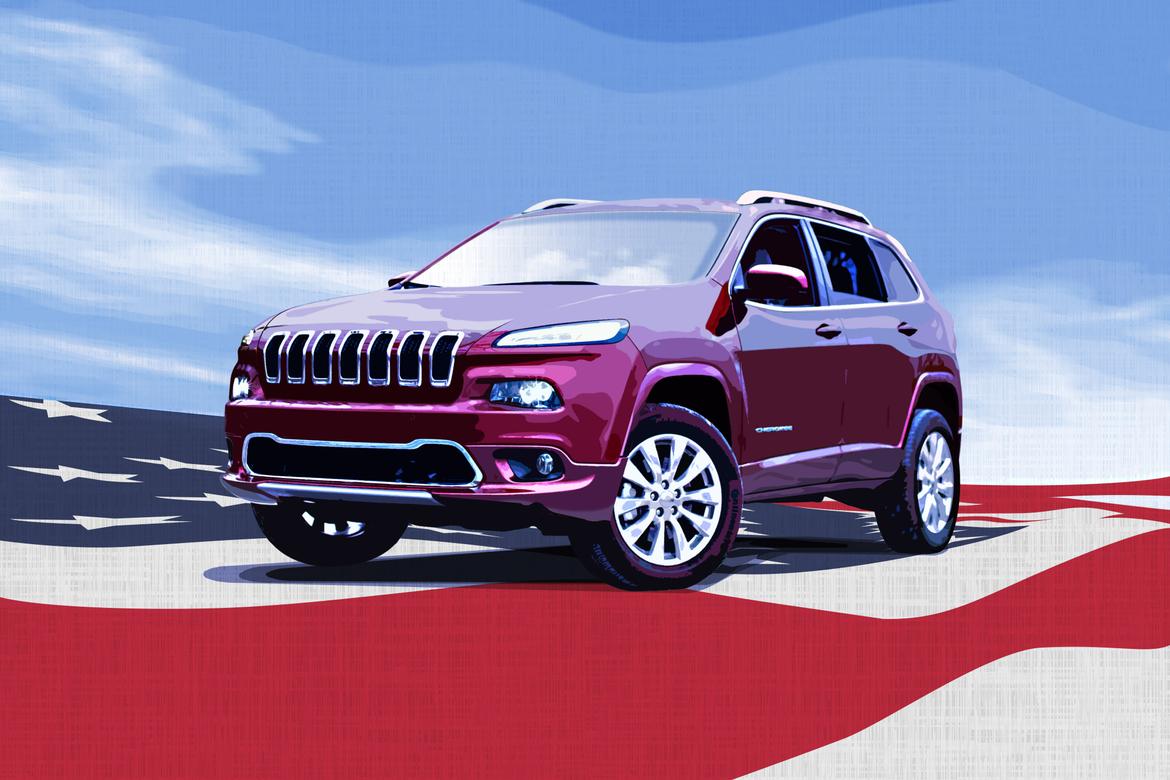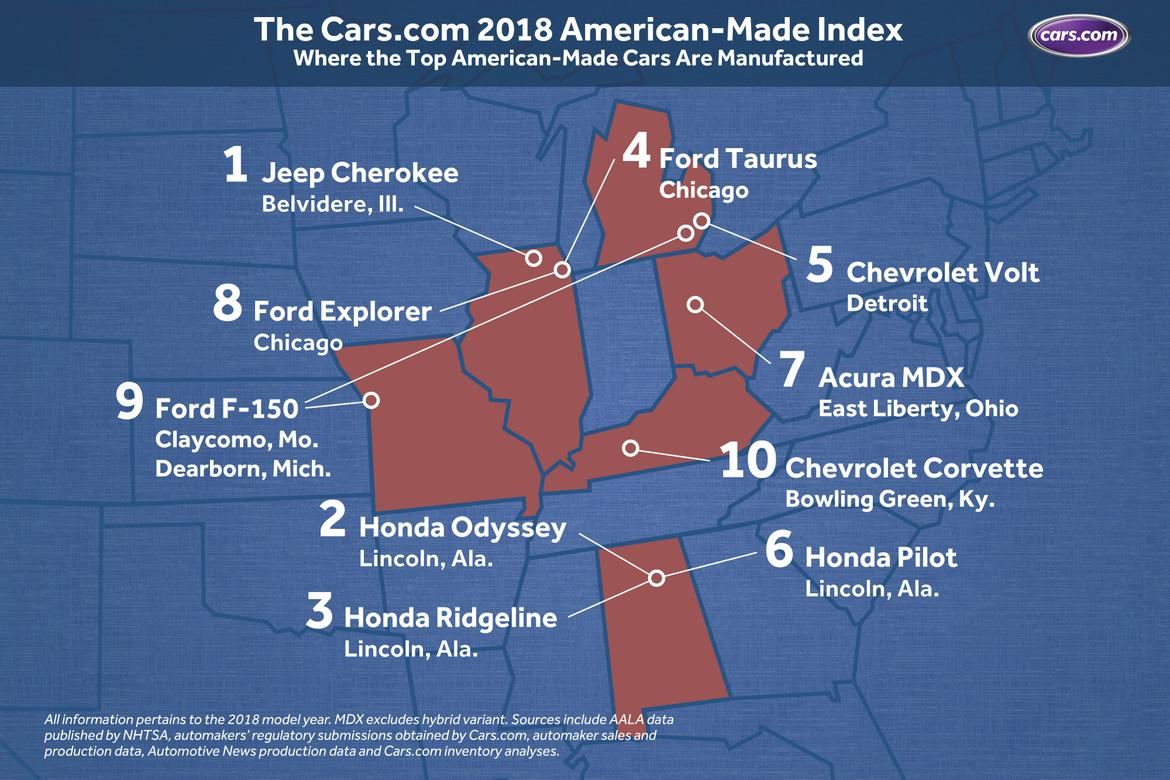
for consumers who want to support the u.s. economy, determining a product's homegrown credentials is no easy task in today's global economy — but it's an important question amid a new era of import tariffs and ongoing renegotiations of long-standing trade pacts. few origin stories are as complicated as that of a modern automobile, whose badge and even assembly location don't tell the whole story. enter 's american-made index, which ranks the most american models on the market. which cars top the list for 2018?
- jeep cherokee: belvidere, ill.
- honda odyssey: lincoln, ala.
- honda ridgeline: lincoln, ala.
- ford taurus: chicago
- chevrolet volt: detroit
- honda pilot: lincoln, ala.
- acura mdx: east liberty, ohio
- ford explorer: chicago
- ford f-150: claycomo, mo., and dearborn, mich.
- chevrolet corvette: bowling green, ky.
all information pertains to the 2018 model year. mdx excludes hybrid variant. sources include aala data published by nhtsa, regulatory submissions from automakers to nhtsa obtained by , automaker sales and production data, automotive news production data and inventory analyses.

the 2017 american-made index's no. 1 jeep wrangler was redesigned for the 2018 model year, and the 2018 wrangler's decreased domestic content knocked it off the top 10 entirely, but in its place is another jeep suv: the cherokee, last year's no. 2 car on the index. with high domestic-parts content — 72 percent for the 2018 model year — and all used engine and transmissions from the u.s., the illinois-built cherokee topped more than 100 u.s.-built vehicles on 's 2018 american-made index. honda's odyssey minivan and ridgeline pickup truck round out the podium; both vehicles are built in alabama with high domestic content and u.s.-sourced drivetrains.
related: 2018 american-made index: what about the least american cars?
the chicago-built ford taurus ranks no. 4, followed by the ami's highest-ranked newcomer, the no. 5 chevrolet volt. plug-in cars, be they fully electric or a plug-in hybrid like the volt, often lack high domestic content amid global sourcing for batteries — one of the most cost-intensive aspects of any car with a significant electric driving range. but the volt's battery is assembled near detroit, with cells from a plant in western michigan. its domestic content, 66 percent for 2018, lands it in the top 10.
the volt is one of four new models — along with the acura mdx, ford explorer and chevy corvette — that didn't appear on the 2017 ami, when redesigned the index to analyze more factors and focus on the impact of each single vehicle purchase. (results from the 2006-16 amis can't be compared to those from 2017 onward because of the change in methodology.)
under the ami hood
by and large, consumers agree that where a car is built is fundamental to its economic impact. in a survey of more than 1,000 licensed drivers, 83 percent named assembly location as an important factor in determining economic impact. yet more than 7 in 10 survey respondents said other factors surpass economic impact in their purchase decision, and nearly 3 in 10 said they care only a little or not at all about economic impact. that bears out when looking at sales of domestically produced vehicles: a analysis of automotive news data found that cars built in america account for only about 53 percent of passenger-vehicle sales in the u.s. through the first quarter of 2018.
u.s. assembly is a critical component of ami eligibility, but that factor alone doesn't guarantee a seat at the table. now in the second year of its overhauled methodology, the ami considers five major factors to zero in on the economic impact of a given model: assembly location, domestic-parts content as determined by the american automobile labeling act, used engine sourcing, transmission sourcing and factory jobs provided by each automaker's u.s. plants.
aala domestic-parts content is the only public content-rating system for cars, but the decades-old legislation is far from perfect. for starters, it doesn't distinguish between canadian and u.s. parts. that's why the american-made index analyzes used engine and transmission sourcing — to ensure two of the most cost-intensive components in any car are from the u.s., not canada. second, aala doesn't fully capture the value of labor, so the ami considers factory labor in a workforce calculation.
the american-made index disqualifies cars below the top 40 percent of the current crop of domestic-parts content ratings — a fluid threshold depending on the year — as well as any models that face immediate discontinuation without a u.s.-built successor. for cars sold here that hail from u.s. and foreign assembly plants, the ami also accounts for foreign production, as it does for used engine or transmissions that hail from non-u.s. regions. the ami does not count fleet-only nameplates, like the ford police interceptor, or those with fewer than 2,500 sales in the first quarter of 2018, as it's unlikely you'll find many at a dealership. finally, cars with a gross vehicle weight rating of greater than 8,500 pounds (that is, heavy-duty trucks and commercial vehicles) are exempt from aala ratings and thus not counted by the ami.
the jobs impact
a analysis of factory employment found that auto plants across the u.s. directly owned by automakers provide some 250,000 jobs — everything from vehicle assembly to drivetrain production, casting and stamping. thousands more employees work in white-collar positions that cover everything from product development to marketing.
a 2015 study by the center for automotive research found the u.s. auto industry directly employed some 322,000 at the time. but two larger workforces sprang out from that: 521,000 people building auto parts and 710,000 people working at new-car dealerships, according to car's study. think of it this way: for every 20 people employed in the auto industry, four of them work at the automaker itself, but about seven work in auto-parts manufacturing. and the biggest group — nine — are employed at new-car dealerships.
of course, that doesn't include independent mechanics and body shops, auto-parts stores, gas stations and much more. such is the domino effect of building vehicles: car estimated in 2015 that every direct u.s. employee at an automaker generated 6.6 additional jobs.
's editorial department is your source for automotive news and reviews. in line with 's long-standing ethics policy, editors and reviewers don't accept gifts or free trips from automakers. the editorial department is independent of 's advertising, sales and sponsored content departments.


